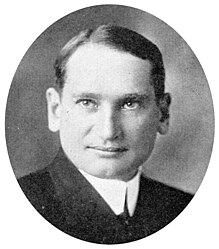Minnie J. Nielson
Minnie Jean Nielson (January 18, 1874 – February 27, 1958) was an American educator and literacy activist from North Dakota.
Nielson was born in Jackson, Michigan, on January 18, 1874,[1] to Scottish parents James Wylie Nelson and Mary Hallady Stewart.
[2][4] In 1919, Fargo College honored Nielson with a Doctor of Laws degree to commemorate her achievements as an educator and for her work with liberty loan drives during World War I.
[12] The biggest issue from Nielson's opponents revolved around the fact that she had attended multiple colleges and universities, but she had not earned any degrees from them.
In a September 1918 letter, he wrote, "They have a Miss Nielson after me; a dear, fat old maid, who is making a campaign on three issues, namely: One, that she is a woman, second, that she is poorly educated, and therefore anything and everything can teach school if she is elected, third, that she and her friends are against the League, and fourth that she is a Scandinavian; all of which is true except the last one, for it happens that her father and mother were born in Scotland.
About two weeks before the election, Nielson asked Langer to issue an opinion on whether she met the legal qualifications to serve as the state superintendent or not.
In early January 1919, Nielson and her staff arrived in Bismarck at the Capitol to move into the office of the Superintendent of Public Instruction.
There had been growing speculation prior to the start of the regular session that Governor Frazier and the NPL would push to overhaul the state's education system.
This would include the duties of Nielson as Superintendent of Public Instruction, who has just defeated Frazier's long-time friend Macdonald in the election.
[28] After the supreme court ruling, the Macdonalds were escorted out of the state superintendent's office by Governor Frazier, along with the sheriff of Burleigh County.
"[26] Only a couple of days earlier, Governor Frazier had given his address to the legislature, recommending they strip away powers from the state superintendent and give them to a new education board.
With the situations with the Macdonalds, the legislature, and the governor all happening at the same time, she simply replied, "My business is education, not politics.
"[26] With full control of the house, senate, and governor's office, the NPL began passing sweeping reforms during the 1919 legislative sessions.
[29] Heeding the governor's recommendation, and the endorsement of many college and university leaders in the state, the legislature also created the Board of Administration.
The other two members were John N. Hagan, Commissioner of Agriculture and Labor; and Minnie Nielson, Superintendent of Public Instruction.
[39] The board appointed Neil C. Macdonald, the former state superintendent, to serve as educational advisor and general school inspector.
[40][41][21] Nielson and Langer asked the Supreme Court to clarify if the legislature had the authority to remove duties of the Superintendent of Public Instruction.
In this report, the board submitted a recommendation to abolish the office of the state superintendent or make it a board-appointed position instead of an elected one.
"[45] In December 1919, Nielson, as a member of the Board of Administration, made statements about being excluded[48][49] when called to testify before the House's committee investigating the state library for controversial items within their collections.
[50] During the backdrop of the First Red Scare, and a growing concern that the NPL had socialist leanings, there were accusations that items within the traveling collection were related to free love, Bolshevism, socialism, and/or anarchism.
[50][51][34] The Independent Voters Association (IVA) used these books and the exclusion of Nielson to their advantage by publicly challenging and smearing the NPL and the Board of Administration.
The IVA slowly gained traction, taking control of one legislative house in 1920 and successfully holding a recall election that deposed Governor Frazier in 1921.
[57] During her time as state superintendent, she sponsored a night school program for adults in counties across the country, teaching them to read and write.
In 1938, she came back to North Dakota and served in a leading role for the Teachers' Insurance and Retirement Fund from that year until 1950.





